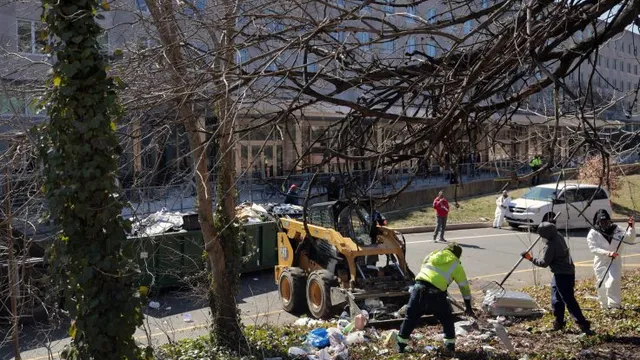
Trump orders D.C. mayor to remove homeless encampments
2025-03-08 03:20- President Donald Trump demanded the removal of homeless encampments in Washington D.C.
- Following Trump's warning, cleanup operations began near the State Department on March 7.
- This federal pressure highlights ongoing concerns about homelessness and public safety in the nation's capital.
Express your sentiment!
Insights
On March 5, 2025, President Donald Trump issued a public warning to Washington, D.C. Mayor Muriel Bowser demanding the removal of homeless encampments in the nation's capital. This directive came amid rising public concern over visible encampments near prominent locations such as the State Department and the White House. Trump stressed that it was essential for Washington D.C. to be perceived as clean and safe, pointing fingers at local leadership's failure to adequately address the issue of homelessness and visible encampments contributing to the city’s image problem. In his warning, Trump asserted that if Mayor Bowser did not act decisively to clear these encampments, the federal government would be compelled to intervene and take over responsibility for the cleanup efforts. Following Trump's ultimatum, D.C. authorities moved quickly, with crews starting to clear a homeless encampment near the State Department on March 7, just two days after the warning. Video footage showed officials dismantling tents and evicting individuals living in the encampment. This swift action was a change from earlier city plans that included the removal of ten other encampments set between February 27 and March 13, with the recent cleanup expedited after Bowser's call with the Trump administration. Despite the federal pressure, Bowser defended her administration’s approach to homelessness and encampment removal, emphasizing established protocols that prioritize residents' wellbeing. During a press conference, she stated that the city always follows protocols when clearing encampments, including providing notice and offering shelter options to those displaced. Addressing increasing rates of homelessness, she acknowledged that encampments were on the rise, but also pointed out that the numbers remained lower than the peak seen during the COVID-19 pandemic. The mayor's office had begun notifying residents of the encampments about the cleanup operation set for March 7, allowing them a 24-hour window to vacate the area. A city spokeswoman mentioned that Bowser's decision to expedite cleanup near the State Department came after collaboration with the Trump administration following the President's warning. Additionally, encampments located on federal property necessitate coordination between city officials and federal agencies, complicating efforts to address the issue effectively. There are acknowledged hurdles for homeless individuals wanting to enter shelters, highlighting the complexity of addressing homeless needs in the region. As the nation prepares to reach the milestone of its 250th anniversary, concerns about crime and homelessness within D.C. remain at the forefront of political debates and actions. The recent federal intervention call from Trump underlines a growing national sentiment regarding homelessness and the need for local governments to take more effective action toward providing solutions and improving urban conditions for all residents.
Contexts
Federal intervention in local homelessness issues serves as a critical nexus between government policy and the pressing need to address one of society's most persistent challenges. Homelessness is a multifaceted issue influenced by various factors, including economic instability, lack of affordable housing, mental health issues, and systemic inequalities. Local governments, often overwhelmed by the complexities of this crisis, have increasingly turned to federal support to bolster their efforts. This intervention ranges from financial assistance to policy frameworks aiming to streamline local responses to homelessness while ensuring the implementation of best practices. The federal government has developed programs such as the Emergency Solutions Grant (ESG) and the Continuum of Care (CoC) framework which are crucial for local jurisdictions in their battle against homelessness. These programs provide funding for emergency shelters, transitional housing, and supportive services tailored to prevent homelessness and assist those in need. Furthermore, initiatives that push for coordinated entry systems—where individuals and families experiencing homelessness can access resources—have been promoted at the federal level to ensure a more systematic and efficient response. Localities can utilize these federal resources to effectively respond to homelessness in a manner that fits their unique socio-economic contexts. However, federal involvement is not without its challenges. Many local jurisdictions often find themselves navigating a maze of regulations and compliance requirements dictated by federal funding. This can lead to bureaucratic delays and may detract from the flexibility needed to tailor solutions to specific community needs. Additionally, reliance on federal funding can pose risks, especially during budget cuts or shifts in political priorities, which might undermine the sustainable efforts to address homelessness. Therefore, local governments are encouraged to develop multifaceted strategies which consider both federal assistance and grassroots initiatives. Ultimately, while federal intervention has been a vital lifeline for localities grappling with homelessness, it must be approached as part of a larger, collaborative strategy that incorporates local insights and innovations. Successful programs often reflect a blend of resources and frameworks offered by both federal and local entities, which can adapt to the evolving landscape of homelessness. For federal assistance to genuinely make an impact, there must be strong partnerships with local stakeholders, including non-profits and community organizations, fostered through transparent communication and aligned goals.